*NURSING > QUESTIONS and ANSWERS > ati Complex Endocrine Questions & Answers_Detailed Answer Key(Latest Complete Solutions. (All)
ati Complex Endocrine Questions & Answers_Detailed Answer Key(Latest Complete Solutions.
Document Content and Description Below
Detailed Answer Key ATI Complex Endocrine Questions & Answers 1 A nurse is caring for a client who is 1 day postoperative following a subtotal thyroidectomy. The client reports a tingling sensation... in the hands, the soles of the feet, and around the lips. For which of the following findings should the nurse assess the client? A. Chvostek's sign B. Babinski's sign C. Brudzinski's sign D. Kernig's sign 2. A nurse is caring for an adolescent client who has a long history of diabetes mellitus and is being admitted to the emergency department confused, flushed, and with an acetone odor on the breath. Diabetic ketoacidosis is suspected. The nurse should anticipate using which of the following types of insulin to treat this client? A. NPH insulin B. Insulin glargine C. Insulin detemir D. Regular insulin Detailed Answer Key ATI Complex Endocrine Practice Regular insulin is classified as a short-acting insulin. It can be given intravenously with an onset of action of less than 30 min. This is the insulin that is most appropriate in emergency situations of severe hyperglycemia or diabetic ketoacidosis. 3. A nurse is assessing a client who has diabetes insipidus. Which of the following findings should the nurse expect? A. Dehydration B. Polyphagia C. Hyperglycemia D. Bradycardia 4. A nurse is caring for a client who has diabetes insipidus and is receiving vasopressin. The nurse should identify which of the following findings as an indication that the medication is effective? A. A decrease in blood sugar B. A decrease in blood pressure C. A decrease in urine output D. A decrease in specific gravity 5. A nurse is reviewing the arterial blood gas (ABG) results of a client who the provider suspects has metabolic acidosis. Which of the following results should the nurse expect to see? Detailed Answer Key ATI Complex Endocrine Practice A. pH below 7.35 B. HCO3 above 26 mEq/L C. PaO2 below 70 mm Hg D. PaCO2 above 45 mm Hg 6. A nurse is caring for a client who is 8 hr postoperative following a subtotal thyroidectomy. In which of the following positions should the nurse keep the client? A. High Fowler's with neck extended B. High Fowler's with neck in a neutral position. C. Semi-Fowler's with neck extended D. Semi-Fowler's with neck in a neutral position 7. A nurse is reviewing a client’s laboratory report of blood gas findings: HCO3- 18 mEq/L and PaCO2 28 mm Hg. Which of the following pH values and conditions should the nurse expect when interpreting these findings? A. Decreased pH and metabolic acidosis Detailed Answer Key ATI Complex Endocrine Practice B. Decreased pH and respiratory acidosis C. Elevated pH and metabolic alkalosis D. Elevated pH and respiratory alkalosis 8. A nurse is monitoring a client who is postoperative following a thyroidectomy. Which of the following data should the nurse identify as the priority to monitor? A. Airway patency B. Temperature C. Urination D. Pain control 9. A nurse is caring for a client who has metabolic alkalosis. For which of the following clinical manifestations should the nurse monitor? (Select all that apply.) A. Bicarbonate excess B. Kussmaul's respirations C. Flushing D. Circumoral paresthesia E. Lethargy Detailed Answer Key ATI Complex Endocrine Practice experiencing metabolic alkalosis.Kussmaul's respirations is incorrect. Kussmaul's respirations are a clinical manifestation for a client experiencing metabolic acidosis.Flushing is incorrect. Flushing is a clinical manifestation for a client experiencing respiratory acidosis.Circumoral paresthesia is correct. Circumoral paresthesia is a clinical manifestation for a client experiencing metabolic alkalosis.Lethargy is incorrect. Lethargy is a clinical manifestation for a client experiencing metabolic acidosis. 10.A nurse is admitting a client who has influenza and is reporting numbness and tingling of the toes and fingers. The nurse should recognize the client is experiencing which of the following acid-base imbalances? A. Metabolic acidosis. B. Metabolic alkalosis C. Respiratory acidosis D. Respiratory alkalosis 11.A nurse is caring for a client who has the following arterial blood gas results: HCO3 18 mEq, PaCO2 28 mm Hg and pH 7.30. The nurse recognizes the client is experiencing which of the following acid base imbalances? A. Metabolic acidosis B. Respiratory acidosis C. Metabolic alkalosis D. Respiratory alkalosis Detailed Answer Key ATI Complex Endocrine Practice A client experiencing respiratory alkalosis would an increased pH, a normal (or slightly decreased if compensated) HCO3 and a decreased PaCO2. 12.A nurse is caring for a client who has diabetic ketoacidosis. Which of the following manifestations should the nurse expect? A. Malignant hypertension B. Acetone odor to breath C. Cheyne-Stokes breathing D. Blood glucose level below 40 mg/dL 13.A nurse is assessing a client who has type 1 diabetes mellitus and finds the client lying in bed, sweating, and reporting feeling anxious. Which of the following complications should the nurse suspect? A. Hypoglycemia B. Nephropathy C. Hyperglycemia D. Ketoacidosis Detailed Answer Key ATI Complex Endocrine Practice 14.A nurse is assessing a client who has Graves' disease. The nurse should expect which of the following laboratory results? A. Decreased thyroid-stimulating hormone (TSH) level B. Decreased triiodothyronine (T3) level C. Decreased thyroxine (T4) level D. Decreased thyroid-stimulating immunoglobulins (TSI) percentage 15.A nurse in an emergency department is caring for a client who has diabetic ketoacidosis (DKA) and a blood glucose level of 925 mg/dL. The nurse should anticipate which of the following prescriptions from the provider? A. Glucocorticoid medications B. Dextrose 5% in 0.45% sodium chloride level reaches 250 mg/dL to prevent hypoglycemia and cerebral edema. C. Oral hypoglycemic medications D. 0.9% sodium chloride IV bolus 16.A nurse is collecting the medical history from a client who has manifestations of syndrome of inappropriate antidiuretic hormone (SIADH). The nurse should ask the client if he has a history of which of the following conditions that can cause SIADH? Created on:08/13/2018 Page 7 Detailed Answer Key ATI Complex Endocrine Practice A. Osteoarthritis B. Lung cancer C. Liver cirrhosis D. Dyspepsia 17.A nurse is caring for a client who is 1 day postoperative following a thyroidectomy and reports severe muscle spasms of the lower extremities. Which of the following actions should the nurse take? A. Check the pedal pulses. B. Verify the most recent calcium level. of the parathyroid gland during surgery. The parathyroid glands are four small glands located inside the thyroid gland that are responsible for calcium regulation. If they are damaged during a thyroidectomy, there is a risk of hypocalcemia. Low calcium levels can be manifested as numbness and tingling of the fingers and around the mouth, muscle spasms (particularly of the hands and feet), and hyperactive reflexes. If a client develops any of these manifestations following a thyroidectomy, the nurse should check the client's latest calcium level. The expected reference range for calcium is 8.5 to 10.5 mg/dL. If the calcium level is low, the provider should be notified, and oral or intravenous calcium replacement should be administered. C. Request prescription for a relaxant. D. Administer an oral potassium supplement. Detailed Answer Key ATI Complex Endocrine Practice a potassium supplement to a client who has confirmed hypokalemia. 18.A nurse is planning care for a client who has a new diagnosis of diabetes insipidus. Which of the following interventions should the nurse include in the plan of care? A. Measure blood glucose levels every 4 hr. B. Administer a diuretic. C. Initiate fluid restrictions. D. Check urine specific gravity. 19.A nurse is caring for a client who is in a myxedema coma. Which of the following actions should the nurse take? A. Turn the client ever 4 hr. B. Check the client’s blood pressure every 2 hr. C. Initiate measures to cool the client. D. Place the client on aspiration precautions. 20.A nurse is planning care for a client who is postoperative following a thyroidectomy. Which of the following interventions should the nurse include in the plan? Detailed Answer Key ATI Complex Endocrine Practice A. Instruct the client to deep breathe every 4 hr. B. Check the client’s voice every 2 hr. C. Place the head of the client’s bed in the flat position. D. Hyperextend the client’s neck. 21.A nurse is caring for a client who had total thyroidectomy and a serum calcium level of 7.6 mg/dL. Which of the following findings should the nurse expect? A. Tingling of the extremities B. Hypoactive deep tendon reflexes. C. Shortened QT intervals. D. Constipation 22.A nurse is caring for a client who has uncontrolled type 1 diabetes mellitus. Which of the following findings should the nurse expect? A. Hypertension B. Hematuria C. Weight loss D. Bradycardia 23.A nurse is reviewing the laboratory results for four clients. The nurse should recognize which of the following clients has a manifestation of hypoparathyroidism? A. A client who has a vitamin D of 25 ng/mL B. A client who has a magnesium of 1.8 mEq/L C. A client who has a calcium of 9.8 mg/dL D. A client who has a phosphate of 5.7 mg/dL 24.A nurse is assessing four clients on a medical unit. The nurse should identify which of the following clients as exhibiting positive manifestations of hypercortisolism? A. A client who has a butterfly rash on his face. B. Moon face C. A client who has a positive Chvostek’s sign. A positive Chvostek’s sign is a manifestation of hypocalcemia. D. A client who has muscle hypertrophy. [Show More]
Last updated: 2 years ago
Preview 1 out of 12 pages
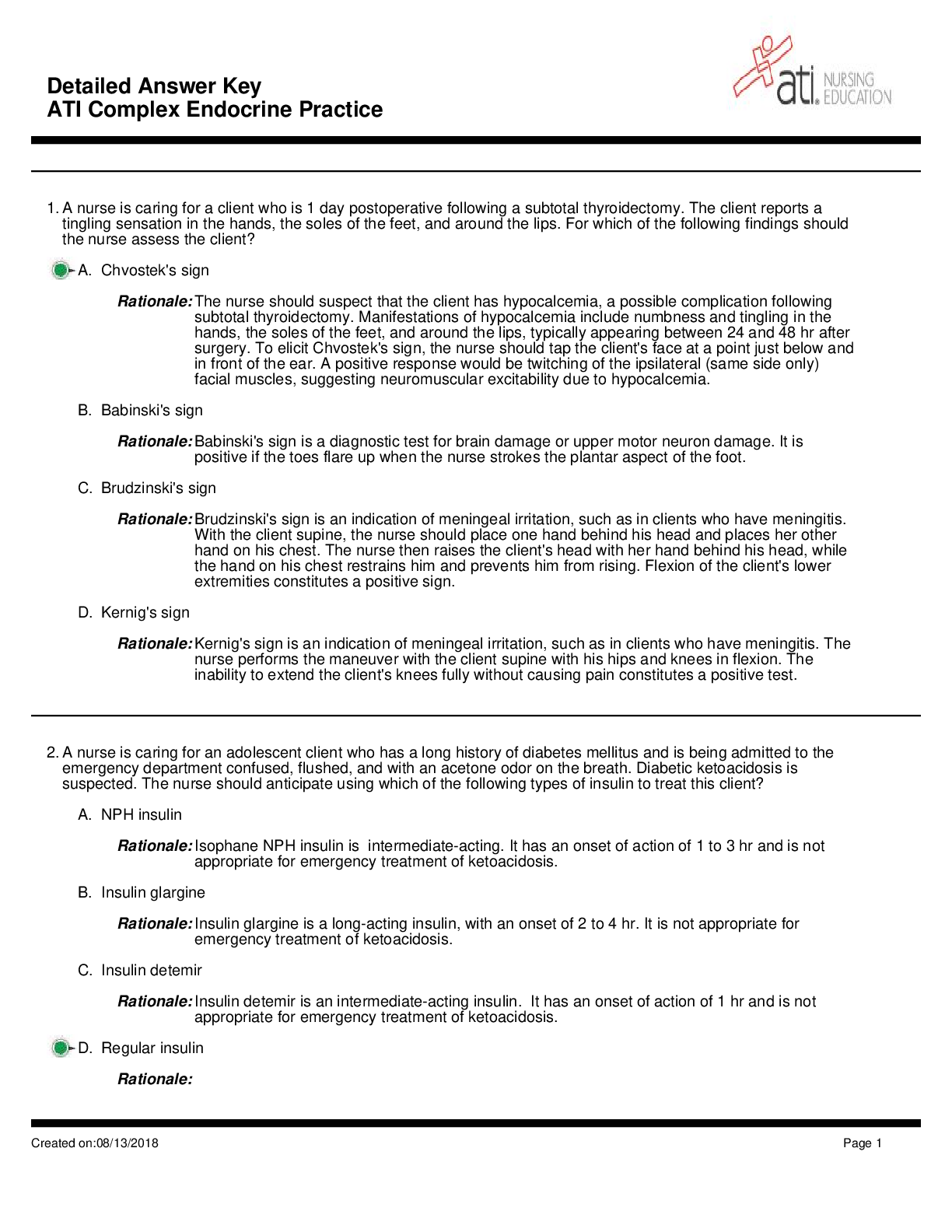
Buy this document to get the full access instantly
Instant Download Access after purchase
Buy NowInstant download
We Accept:

Reviews( 0 )
$15.00
Can't find what you want? Try our AI powered Search
Document information
Connected school, study & course
About the document
Uploaded On
Sep 10, 2020
Number of pages
12
Written in
Additional information
This document has been written for:
Uploaded
Sep 10, 2020
Downloads
1
Views
345


.png)
Perop.png)
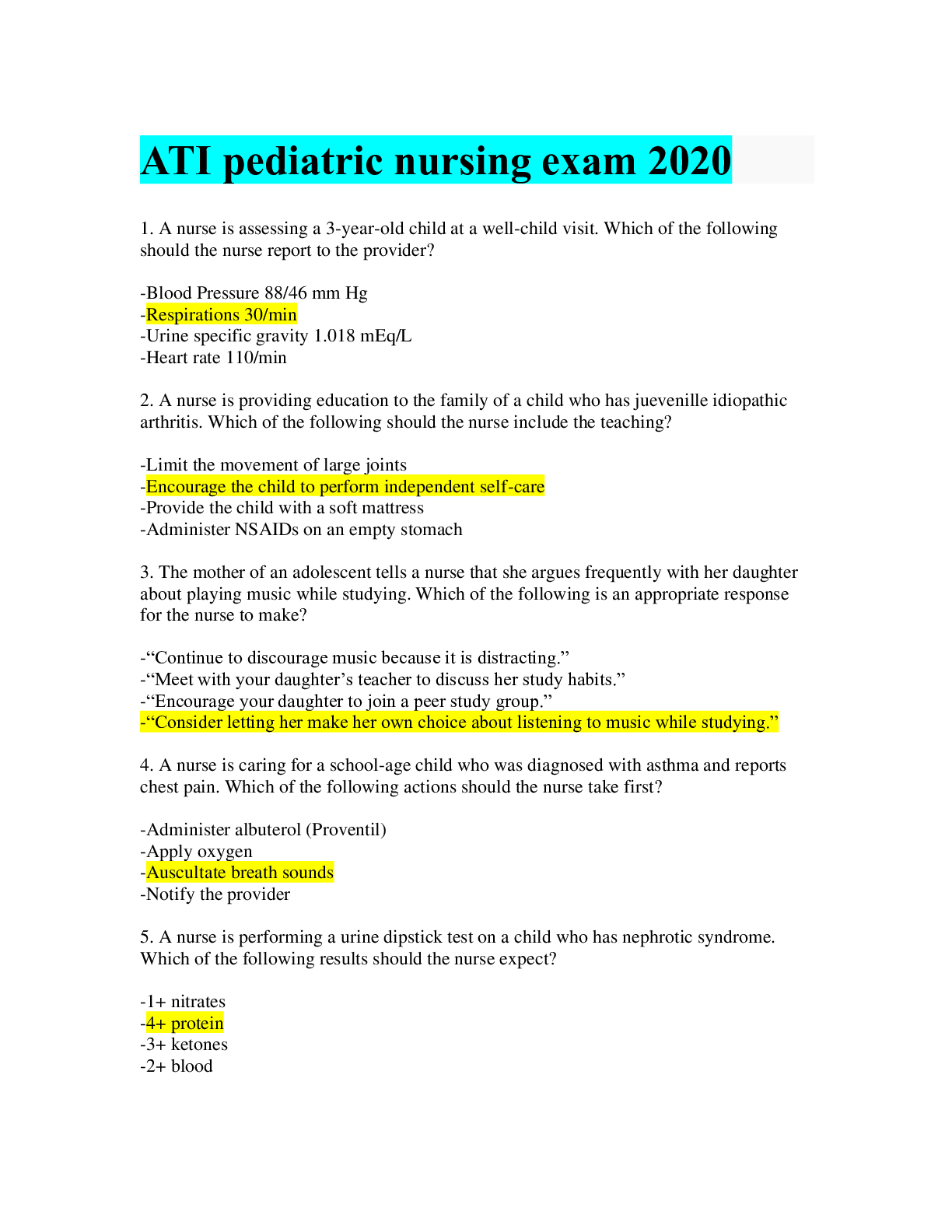
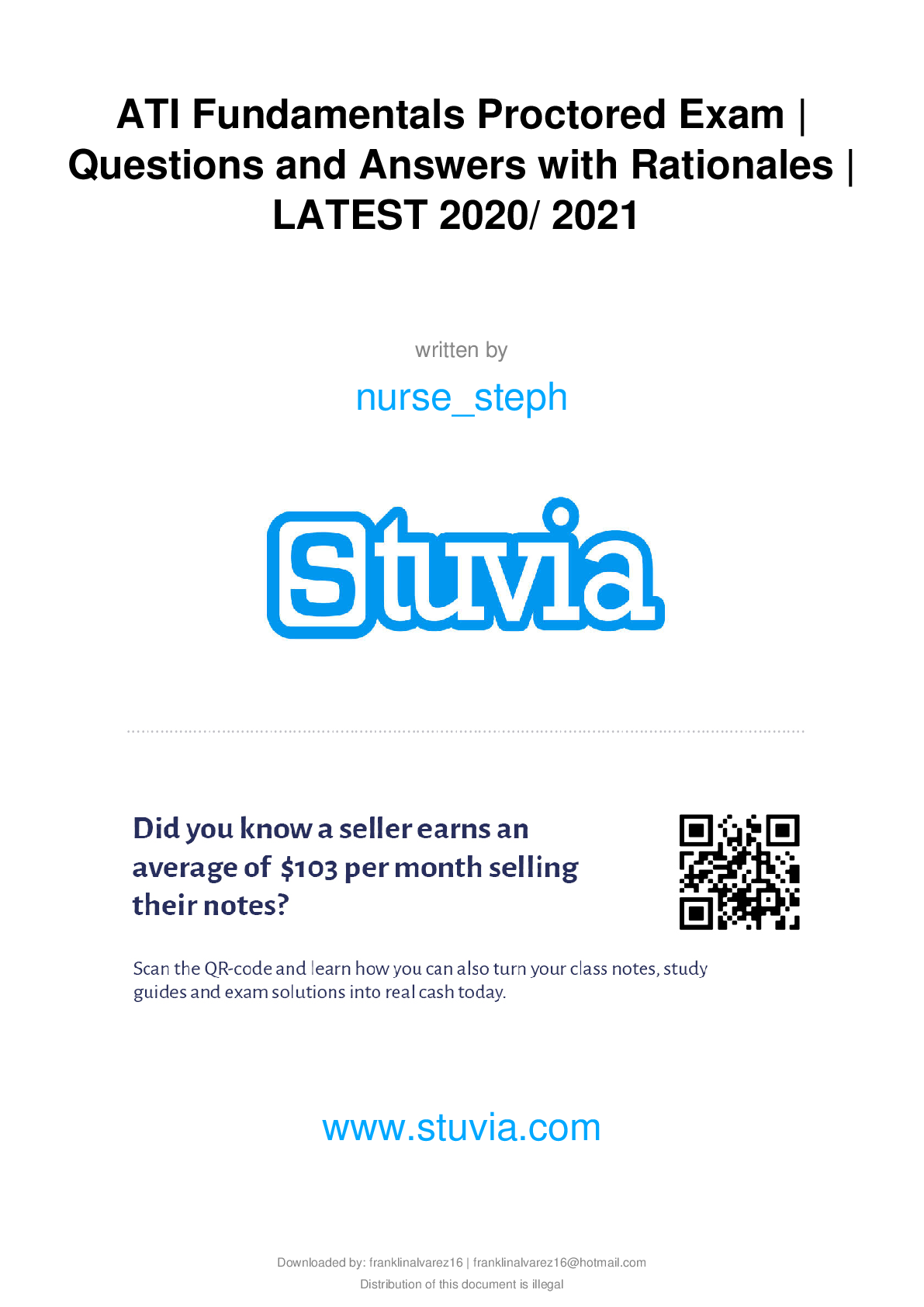
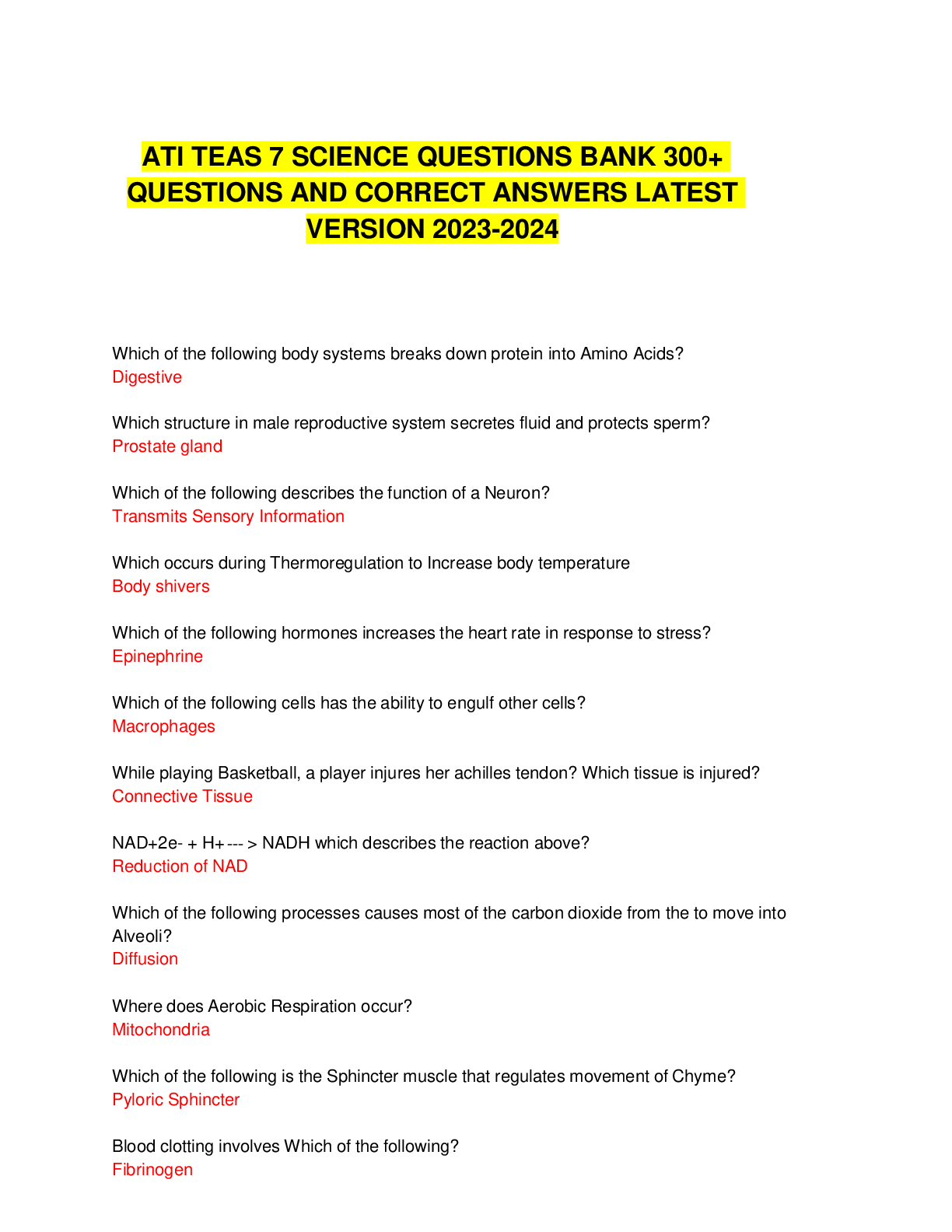


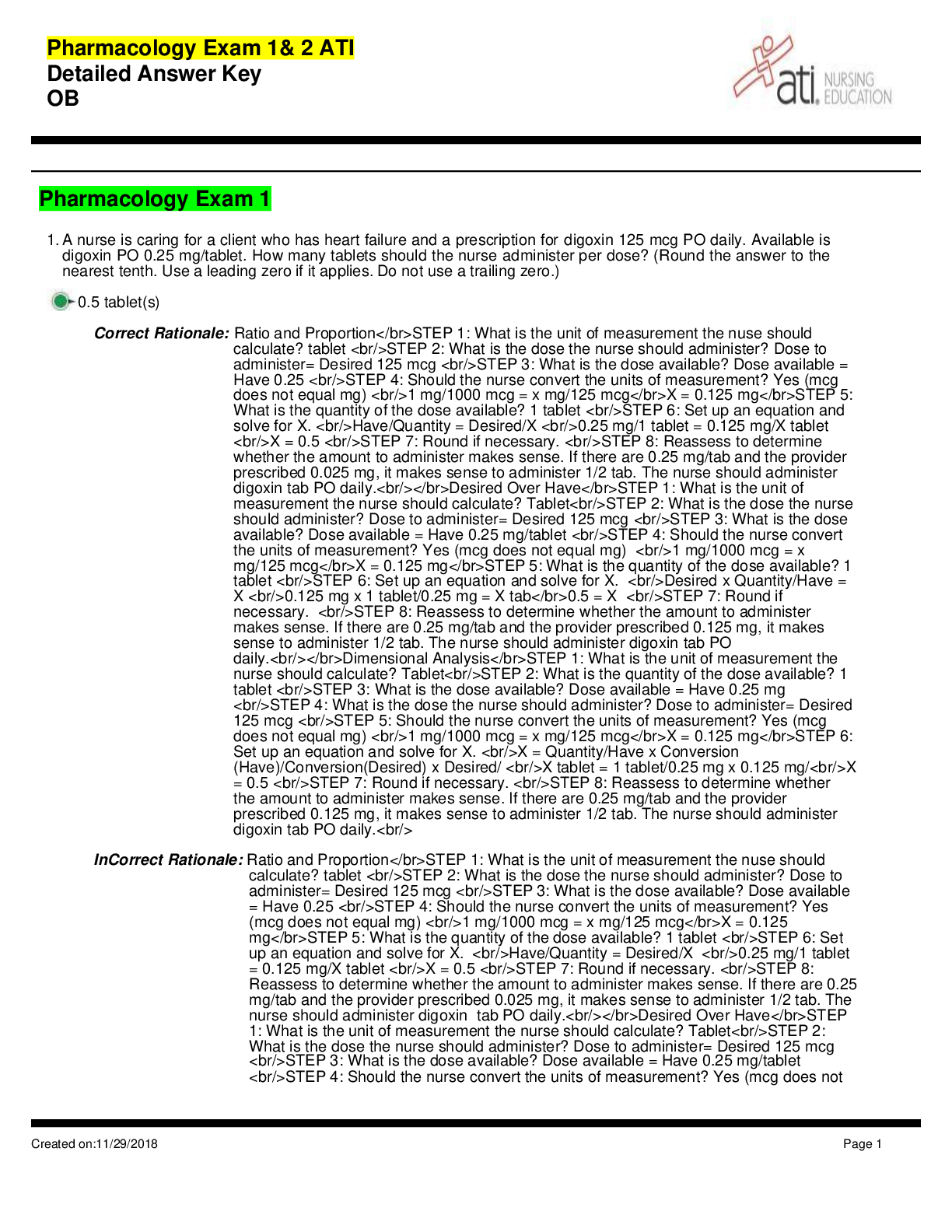
.png)


.png)

